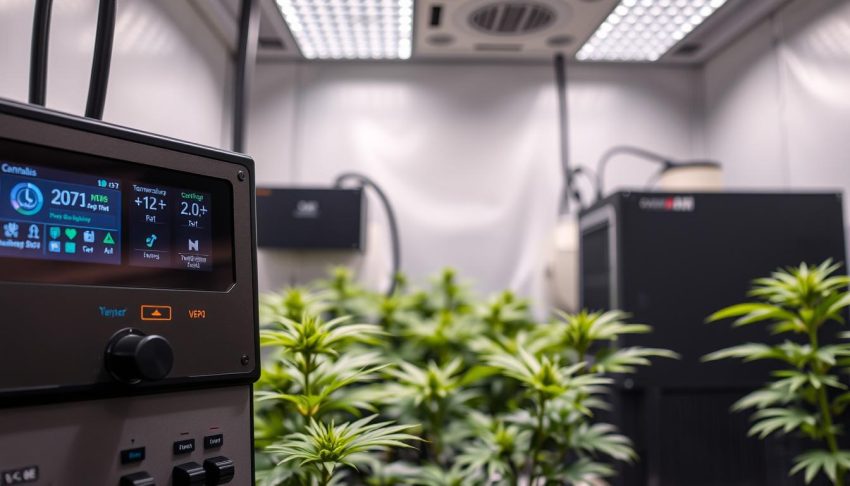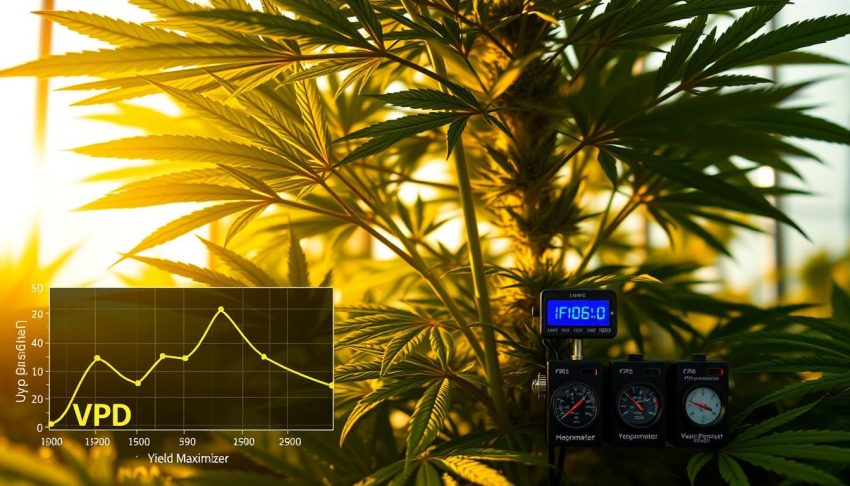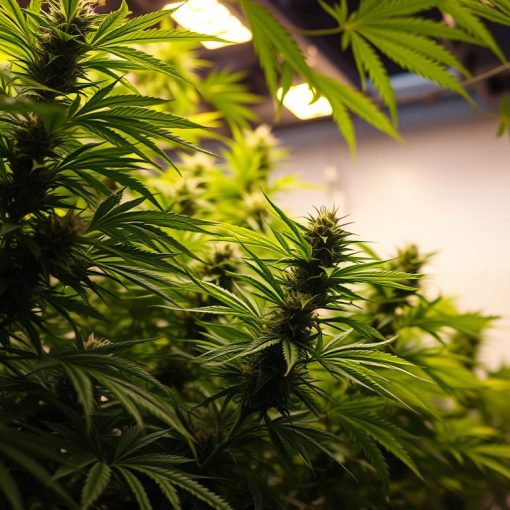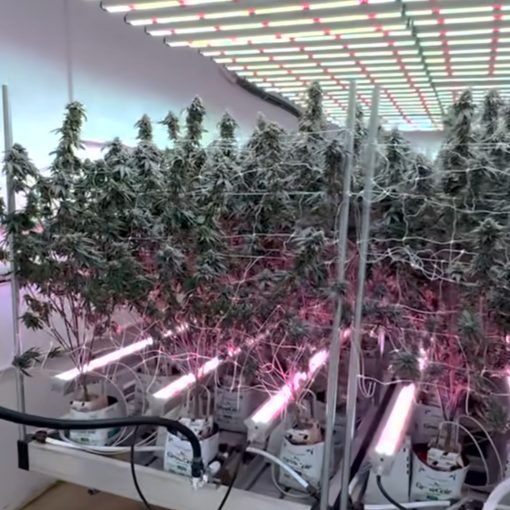Controlling VPD in a cannabis space is key for better yields and plant health. Vapor pressure deficit cannabis is vital in growing cannabis. Knowing how to control VPD helps plants grow well.
To master VPD control, you need to understand how temperature, humidity, and plant growth interact. It’s about monitoring and adjusting these factors to make a perfect growing space. Knowing how vapor pressure deficit cannabis affects plants is crucial.
Introduction to VPD Control
VPD control is vital for cannabis growers wanting to boost yields and plant health. By grasping the basics of VPD for cannabis and controlling it, growers can create the best environment for their plants. Vapor pressure deficit cannabis plays a big role in this, and mastering VPD control is essential for success.
Key Takeaways
- Controlling vpd in a cannabis space is crucial for maximizing yields and plant health
- Vapor pressure deficit cannabis is a critical factor in cannabis cultivation
- Understanding VPD for cannabis is essential for creating an optimal growing environment
- Mastering VPD control requires careful monitoring and adjustment of temperature and humidity
- VPD control is essential for any cannabis grower looking to maximize yields and plant health
- Controlling VPD in a cannabis space involves careful planning and attention to detail
Understanding VPD Fundamentals in Cannabis Cultivation
To grow cannabis well, you need to know about Vapor Pressure Deficit (VPD). VPD is key for plant health and growth. It’s important to control temperature and humidity for the best results.
A vpd chart for cannabis helps find the right VPD for your plants. It shows the best VPD for each growth stage. This helps you control temperature and humidity for healthy growth.
- Temperature: The right temperature changes with the plant’s growth stage.
- Humidity: Keeping humidity just right is vital for healthy growth and disease prevention.
- Light: The type and strength of light affects VPD and plant growth.
Understanding these factors and VPD helps create the best growing space. This leads to healthier plants and more yield. Next, we’ll look at how to balance temperature and humidity for your plants.
The Relationship Between Temperature and Humidity in Cannabis Growing
Cannabis plants need a perfect mix of temperature and humidity to grow well. Cannabis environmental control is key to keeping the right conditions. The ideal VPD range for cannabis is between 0.8 and 1.2 kPa, depending on the temperature and humidity.
Temperature and humidity directly affect VPD and plant transpiration. High temperatures make plants sweat more, raising the VPD. But, high humidity makes plants sweat less, lowering the VPD. Finding the right balance between temperature and humidity is crucial for the best VPD range.
Here are some important tips for controlling temperature and humidity in cannabis growing:
- Keep the day temperature between 68-77°F (20-25°C) and the night temperature between 64-75°F (18-24°C).
- Ensure the relative humidity is between 40-60% during the day and 50-70% at night.
- Watch the VPD and adjust the temperature and humidity as needed.
By managing temperature and humidity, growers can create the best environment for their cannabis plants. This leads to healthier plants, more yields, and better buds. The secret to successful cannabis growing is balancing temperature, humidity, and VPD perfectly.
Optimal VPD Ranges Through Different Growth Stages
Cannabis plants need different vapor pressure deficits (VPD) at each growth stage. Knowing these changes helps growers control their grow room’s climate. This ensures plants grow well. A vpd calculator for growers is useful for finding the best VPD for each stage.
In the vegetative stage, plants need a low VPD for leaf growth. When they start flowering, their VPD needs go up to help buds grow. greatly affect plant yield and quality.
Key Considerations for Each Growth Stage
- Vegetative stage: Keep VPD low (around 0.5-1.0 kPa) for leaf growth and to avoid water stress.
- Flowering stage: Raise VPD (around 1.0-1.5 kPa) for bud growth and to stop mold.
- Drying and curing: Keep VPD stable (around 0.5-1.0 kPa) to keep terpene quality and prevent damage.
Understanding the right VPD for each stage and using a vpd calculator for growers helps improve grow room climate control. This leads to growing high-quality plants with the best yields.
Essential Equipment for Controlling VPD in a Cannabis Space
To keep cannabis growing well, you need the right gear. You need tools that work together to keep the environment stable. It’s all about precision, especially with cannabis vpd and co2 levels.
For those growing indoors, knowing how to adjust VPD is key. The right tools can greatly improve your harvest. Here are some must-haves:
- Humidity control systems to regulate moisture levels
- Temperature management tools to maintain a stable temperature
- Monitoring devices and software to track VPD and CO2 levels
With these tools, growers can create a perfect space for their plants.
Having the right equipment lets growers focus on getting the best results. By controlling VPD and CO2, they can ensure their plants thrive and produce more.
How LED Grow Lights Impact VPD Management
When thinking about how to control VPD in a grow room, the lighting is key. LED grow lights are popular for their energy use and helping plants grow well. Yet, they can change the vpd and cannabis resin production by altering the room’s temperature and humidity.
To get the best humidity levels for cannabis flowering stage right, knowing how LED lights affect the space is vital. Here are important points to remember:
- LED grow lights make less heat than old lights, helping keep the temperature and humidity steady.
- The light’s spectrum and strength can be changed to help plants grow and make more resin.
- Good air flow and ventilation are key with LED lights to stop moisture buildup and keep VPD levels just right.
Understanding how LED grow lights affect VPD management helps growers make better choices. This leads to healthier plants and better growth.
Advanced Strategies for VPD Optimization
For cannabis growers, knowing how VPD impacts yields is key. Indoor and outdoor VPD management differ. Learning to lower VPD in a grow tent boosts yields. Advanced VPD strategies lead to healthier plants and better yields.
Improving VPD control means looking at CO2 supplementation and its role in growth. Optimizing CO2 levels helps plants grow well and increases yields. Also, leaf temperature monitoring helps track plant health, guiding growers to keep conditions perfect.
Seasonal changes require growers to adjust VPD levels. As seasons shift, plants need the right moisture and nutrients. Growers might change temperature, humidity, and add extra light to support growth.
- Monitoring and adjusting CO2 levels to promote healthy plant growth
- Implementing leaf temperature monitoring to track plant health
- Making seasonal adjustments to maintain optimal growing conditions
By using these strategies, growers can create a perfect environment for plants. This leads to healthy growth and higher yields. It answers the question of how VPD affects cannabis yields and shows the difference between indoor and outdoor VPD management.
Troubleshooting Common VPD Issues
Managing vpd for cannabis is key to a healthy crop. The cannabis leaf temperature and vpd relationship greatly affects plant growth. Knowing how to set optimal VPD settings for led grow lights helps plants grow well and increases yields.
Common VPD problems need quick attention. Watch your grow space closely for issues. Some common problems are:
- High VPD, which can cause water stress and reduce plant growth
- Low VPD, which can lead to fungal diseases and root rot
Recognizing these issues and acting fast can save your crop. Good vpd management for cannabis means understanding temperature, humidity, and light. It also means adjusting optimal vpd settings for led grow lights as plants need.
Stay alert and manage cannabis leaf temperature and VPD relationship well. This way, growers can solve common VPD problems and get great results in growing cannabis.
Maximizing Yields Through Proper VPD Control
Controlling VPD is key in growing cannabis. Knowing the right VPD for cannabis helps plants grow well. In a grow room, balancing temperature and humidity is vital for healthy plants and high yields.
Proper vpd control is crucial for great cannabis results. It helps plants grow strong, avoids diseases, and boosts yields. In a grow room, keeping VPD stable is essential for plant health.
Important factors for controlling vpd include:
- Maintaining optimal temperature and humidity levels
- Monitoring and adjusting VPD levels throughout the growth cycle
- Providing adequate ventilation and air circulation
By following these tips, growers can create the best environment for their plants. This leads to higher cannabis yields. Understanding VPD is key to success in growing cannabis.
Conclusion: Achieving Perfect VPD Balance for Your Cannabis Garden
Mastering VPD control is crucial for growing healthy cannabis plants. Knowing how vapor pressure deficit affects plant transpiration helps you create the best environment. This is true for all stages of growth, from vegetative to flowering and drying.
Keeping the perfect VPD balance leads to better growth, higher yields, and success in growing. It’s all about monitoring temperature and humidity, using the right tools, and adjusting for the seasons.
By following the tips in this guide, you’ll get closer to achieving the perfect VPD balance. This will help your cannabis plants reach their full potential. Happy growing!




